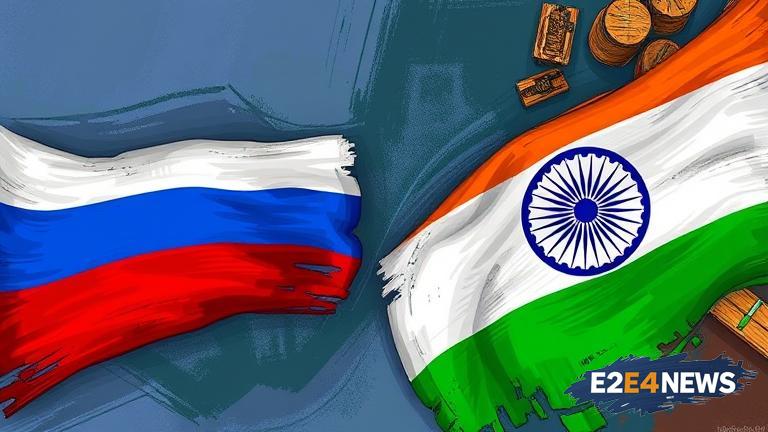The ongoing tariff dispute between the United States and India has taken a new turn with Russia’s intervention. The US had imposed tariffs on Indian goods in response to India’s tariffs on American products, leading to a significant escalation in trade tensions between the two nations. However, Russia’s entry into the fray has added a new layer of complexity to the situation. Russia’s decision to weigh in on the dispute is seen as a strategic move to strengthen its economic ties with India and potentially undermine the US’s position in the region. The US-India tariff spat began when the US imposed tariffs on Indian goods, including steel and aluminum, in response to India’s tariffs on American products such as Harley-Davidson motorcycles and bourbon whiskey. India had imposed these tariffs in retaliation to the US’s tariffs on Indian steel and aluminum imports. The dispute has been ongoing for several months, with both sides refusing to back down. Russia’s intervention comes at a time when the US and India are engaged in diplomatic efforts to resolve the dispute. The US has been pushing India to reduce its tariffs on American goods, while India has been seeking greater access to the US market for its products. Russia’s entry into the dispute is likely to alter the dynamics of the negotiations, with Russia potentially offering India alternative trade arrangements and economic partnerships. This could lead to a significant shift in the balance of power in the region, with Russia emerging as a major player in the US-India trade dispute. The implications of Russia’s intervention are far-reaching, with potential consequences for global trade and economic relations. The US-India tariff spat has already had a significant impact on global trade, with other countries watching the situation closely. The dispute has also highlighted the growing tensions between the US and India, with both countries seeking to assert their economic and strategic interests in the region. Russia’s intervention is likely to add fuel to the fire, with the potential for further escalation in trade tensions between the US and India. Despite the challenges, there are also opportunities for cooperation and collaboration between the US, India, and Russia. The three countries could potentially work together to resolve the dispute and establish new trade arrangements that benefit all parties. However, this would require a significant amount of diplomatic effort and a willingness to compromise on all sides. The US-India tariff spat is a complex issue, with multiple factors at play. The dispute is not just about tariffs, but also about the broader economic and strategic relationships between the US and India. The two countries have a long history of cooperation, but also have significant differences in their economic and strategic interests. Russia’s intervention has added a new layer of complexity to the situation, with the potential for significant consequences for global trade and economic relations. As the situation continues to evolve, it is likely that there will be further developments and twists in the US-India tariff spat. The dispute has significant implications for businesses and investors, with potential consequences for trade and economic growth. Companies that export goods to the US and India are likely to be affected by the tariffs, with potential losses in revenue and profitability. The dispute also has significant implications for the global economy, with potential consequences for trade and economic growth. The World Trade Organization (WTO) has been watching the situation closely, with concerns about the potential impact on global trade and economic relations. The WTO has called for calm and restraint, urging all parties to work together to resolve the dispute. Despite the challenges, there are also opportunities for cooperation and collaboration between the US, India, and Russia. The three countries could potentially work together to resolve the dispute and establish new trade arrangements that benefit all parties. This would require a significant amount of diplomatic effort and a willingness to compromise on all sides. The US-India tariff spat is a complex issue, with multiple factors at play. The dispute is not just about tariffs, but also about the broader economic and strategic relationships between the US and India. Russia’s intervention has added a new layer of complexity to the situation, with the potential for significant consequences for global trade and economic relations. As the situation continues to evolve, it is likely that there will be further developments and twists in the US-India tariff spat. The dispute has significant implications for businesses and investors, with potential consequences for trade and economic growth. Companies that export goods to the US and India are likely to be affected by the tariffs, with potential losses in revenue and profitability. The dispute also has significant implications for the global economy, with potential consequences for trade and economic growth. The WTO has been watching the situation closely, with concerns about the potential impact on global trade and economic relations. The WTO has called for calm and restraint, urging all parties to work together to resolve the dispute. In conclusion, the US-India tariff spat is a complex issue with significant implications for global trade and economic relations. Russia’s intervention has added a new layer of complexity to the situation, with the potential for significant consequences for the global economy. As the situation continues to evolve, it is likely that there will be further developments and twists in the US-India tariff spat.





